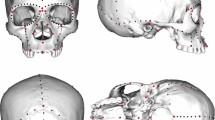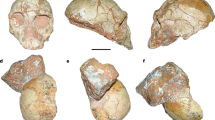Abstract
A current issue on the settlement of the Americas refers to the lack of morphological affinities between early Holocene human remains (Palaeoamericans) and modern Amerindian groups, as well as the degree of contribution of the former to the gene pool of the latter1,2,3,4,5,6. A different origin for Palaeoamericans and Amerindians is invoked to explain such a phenomenon3. Under this hypothesis, the origin of Palaeoamericans must be traced back to a common ancestor for Palaeoamericans and Australians, which departed from somewhere in southern Asia and arrived in the Australian continent and the Americas around 40,000 and 12,000 years before present, respectively. Most modern Amerindians are believed to be part of a second, morphologically differentiated migration3. Here we present evidence of a modern Amerindian group from the Baja California Peninsula in Mexico, showing clearer affinities with Palaeoamerican remains than with modern Amerindians. Climatic changes during the Middle Holocene probably generated the conditions for isolation from the continent, restricting the gene flow of the original group with northern populations, which resulted in the temporal continuity of the Palaeoamerican morphological pattern to the present.
This is a preview of subscription content, access via your institution
Access options
Subscribe to this journal
Receive 51 print issues and online access
$199.00 per year
only $3.90 per issue
Buy this article
- Purchase on Springer Link
- Instant access to full article PDF
Prices may be subject to local taxes which are calculated during checkout


Similar content being viewed by others
References
Neves, W. A. & Pucciarelli, H. M. Morphological affinities of the first Americans: an exploratory analysis based on early South American human remains. J. Hum. Evol. 21, 261–273 (1991)
Powell, J. F. & Neves, W. A. Craniofacial morphology of the first Americans: pattern and process in the peopling of the New World. Yearb. Phys. Anthropol. 42, 153–188 (1999)
Neves, W. A., Powell, J. F. & Ozolins, E. G. Extra-continental morphological affinities of Lapa Vermelha IV, Hominid 1: A multivariate analysis with progressive numbers of variables. Homo 50, 263–282 (1999)
Neves, W. A., Powell, J. F. & Ozolins, E. G. Extra-continental morphological affinities of Palli-Aike, Southern Chile. Interciencia 24, 258–263 (1999)
González-José, R., Dahinten, S. L., Luis, M. A., Hernández, M. & Pucciarelli, H. M. Craniometric variation and the settlement of the Americas: testing hypotheses by means of R matrix and matrix permutation tests. Am. J. Phys. Anthropol. 116, 154–166 (2001)
González-José, R., Neves, W., Hernández, M., Pucciarelli, H. & Correal, C. Late Pleistocene/Early Holocene skulls from Mexico demonstrate the existence of the Paleoamerican morphological pattern in Mesoamerica. (submitted).
Willey, G. R. An Introduction to American Archaeology (Prentice-Hall, New Jersey, 1966)
Rosales-López, A. & Fujita, H. La Antigua California Prehispánica: la Vida Costera en El Conchalito (INAH, México, 2000)
Howells, W. W. Cranial Variation in Man (Papers of the Peabody Museum, Harvard University, Massachusetts, 1973)
Relethford, J. H. & Blangero, J. Detection of differential gene flow from patterns of quantitative variation. Hum. Biol. 62, 5–25 (1990)
Relethford, J. H. & Harpending, H. C. Craniometric variation, genetic theory and modern human origins. Am. J. Phys. Anthropol. 95, 249–270 (1994)
Williams-Blangero, S. & Blangero, J. Anthropometric variation and the genetic structure of the Jirels of Nepal. Hum. Biol. 61, 1–12 (1989)
Relethford, J. H., Crawford, M. H. & Blangero, J. Genetic drift and gene-flow in post famine Ireland. Hum. Biol. 69, 443–465 (1997)
Bookstein, F. L. Principal warps—Thin-Plate Splines and the decomposition of deformations. Trans. Pat. Anal. Mac. Intel. 11, 567–585 (1989)
Goodall, C. R. Procrustes methods in the statistical analysis of shape. J. R. Stat. Soc. B. 53, 285–339 (1991)
Rohlf, F. J. Shape statistics: Procrustes superimpositions and tangent spaces. J. Classif. 16, 197–223 (1999)
Dryden, I. L. & Mardia, K. V. Statistical Shape Analysis (Wiley, Chichester, 1998)
Lahr, M. M. The Evolution of Modern Human Diversity. A Study of Cranial Variation (Cambridge Univ. Press, Cambridge, 1996)
Relethford, J. H. Apportionment of global human genetic diversity based on craniometrics and skin color. Am. J. Phys. Anthropol. 118, 393–398 (2002)
Sparks, C. S. & Jantz, R. L. A reassessment of human cranial plasticity: Boas revisited. Proc. Natl Acad. Sci. USA 99, 14636–14639 (2002)
González-José, R., Van der Molen, S., González-Pérez, E. & Hernández, M. Patterns of phenotypic covariation and correlation in modern humans as viewed from morphological integration. Am. J. Phys. Anthropol. (in the press)
Bradley, R. S. Paleoclimatology: Reconstructing Climates of the Quaternary (Academic, San Diego, 1999)
Haberle, S. Late Quaternary vegetation and climate history of the Amazon Basin: correlating marine and terrestrial pollen records. Proc. Ocean Drilling Prog. Sci. Res. 155, 381–396 (1997)
Baker, P. A. et al. The history of South American Tropical precipitation for the past 25,000 years. Science 291, 640–643 (2001)
Grismer, L. Evolutionary biogeography on Mexico's Baja California peninsula: a synthesis of molecules and historical geology. Proc. Natl Acad Sci. USA 97, 14017–14018 (2000)
Riddle, B. R., Hafner, D. J., Alexander, L. F. & Jaeger, J. R. Cryptic vicariance in the historical assembly of a Baja California Peninsular desert biota. Proc. Natl Acad. Sci. USA 97, 14438–14443 (2000)
Dixon, E. J. Human colonization of the Americas: timing, chronology and process. Quat. Sci. Rev. 20, 277–299 (2001)
Slice, D. E. Morpheus et al. software for morphometric research. Revision 01-30-98 (Department of Ecology and Evolution, State University of New York, Stony Brook, 1998).
Sheets, H. D. Integrated Morphometrics Package (Department of Geology, SUNY at Buffalo, New York, 2001).
Howells, W. W. Skull Shapes and the Map (Papers of the Peabody Museum, Harvard University, Massachusetts, 1989)
Acknowledgements
We would like to thank personnel and authorities of the Instituto Nacional de Antropología e Historia, Museo Nacional de Antropología e Historia (México), and Musée de l'Homme (France) for their collaboration during the data acquisition. We thank P. Nepomnaschy, C. O'Connor, and J. Garrett for comments on the manuscript. We are also indebted to E. Ozolins who made available his data on Palaeoamerican series. This work was partially funded by the Wenner-Gren Foundation for Anthropological Research.
Author information
Authors and Affiliations
Corresponding author
Ethics declarations
Competing interests
The authors declare that they have no competing financial interests.
Supplementary information
41586_2003_BFnature01816_MOESM1_ESM.pdf
Supplementary Table and Figures: Further archaeological information in reference to the Baja California Sur skeletal materials. (PDF 1031 kb)
41586_2003_BFnature01816_MOESM2_ESM.pdf
Supplementary Table and Figures: Illustrating the results of a Relative Warp Analysis performed on the BCS, TLAT, and PAL samples. (PDF 228 kb)
Rights and permissions
About this article
Cite this article
González-José, R., González-Martín, A., Hernández, M. et al. Craniometric evidence for Palaeoamerican survival in Baja California. Nature 425, 62–65 (2003). https://doi.org/10.1038/nature01816
Received:
Accepted:
Issue Date:
DOI: https://doi.org/10.1038/nature01816
This article is cited by
-
Population-specific facial traits and diagnosis accuracy of genetic and rare diseases in an admixed Colombian population
Scientific Reports (2023)
-
Morphometric affinities and direct radiocarbon dating of the Toca dos Coqueiros’ skull (Serra da Capivara, Brazil)
Scientific Reports (2022)
-
The Pre-Columbian Peopling and Population Dispersals of South America
Journal of Archaeological Research (2021)
-
Tracing the peopling of the world through genomics
Nature (2017)
-
Genetic evidence for two founding populations of the Americas
Nature (2015)
Comments
By submitting a comment you agree to abide by our Terms and Community Guidelines. If you find something abusive or that does not comply with our terms or guidelines please flag it as inappropriate.



